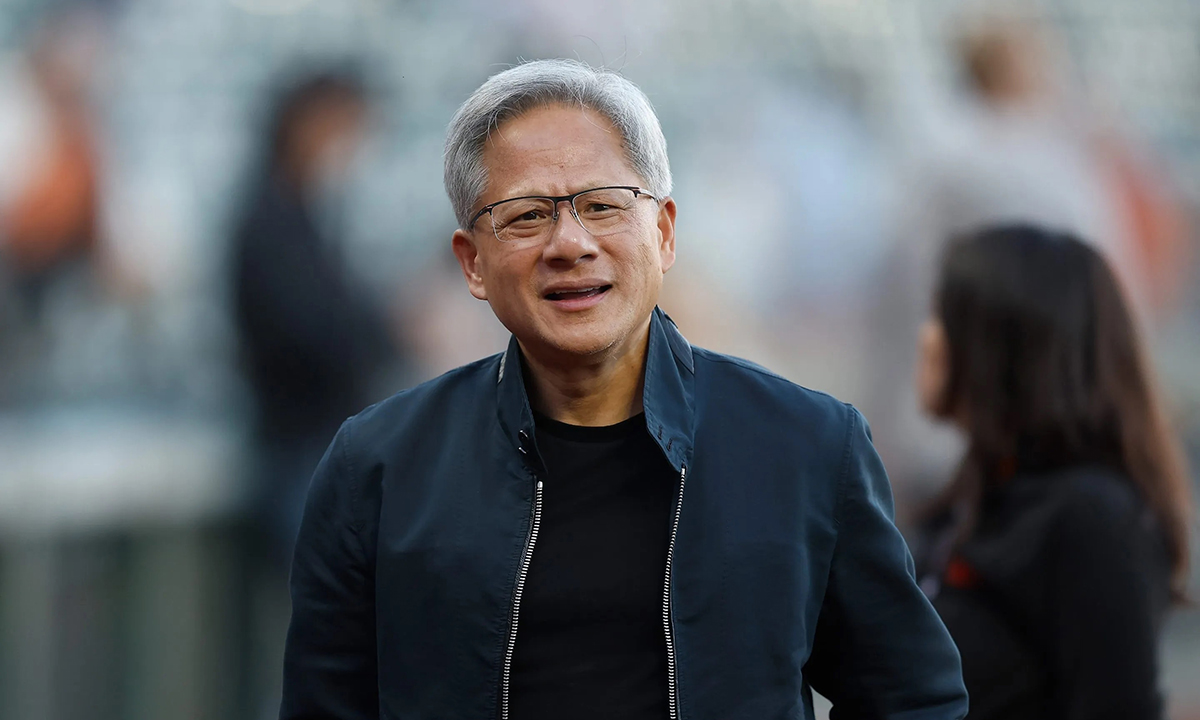
高盛集团(Goldman Sachs)周一表示,人工智能芯片股英伟达的暴跌为投资者提供了一个极具吸引力的切入点。
公司创始人兼首席执行官黄仁勋(Jensen Huang)发布了低调的第三季度业绩指引,引发了人们对其快速增长的盈利可能无法持续的担忧,自那以来,该公司的市值蒸发了17%。目前只有少数几家公司在推动其人工智能芯片业务的蓬勃发展,其中仅四家客户就占了英伟达全部营收的近一半。
高盛集团半导体分析师哈里俊也(Toshiya Hari)在该行主办的科技会议的非正式会议期间接受雅虎财经采访时表示,随着亚马逊(Amazon)、微软(Microsoft)和谷歌(Google)这三大云计算超级巨头以外的客户开始投资自己的人工智能计算集群,他相信销售额将会回升。
“对加速计算的需求仍然非常强劲。”他周一表示,重申了对该股的“买入”建议,并认为该股处于超卖状态。“你会看到,需求组合正扩大到企业,甚至主权国家。”
根据哈里俊也对英伟达2025年利润的估计,由于过去几周的大幅回调,英伟达的市盈率仅为20出头。相比之下,根据雅虎财经的数据,特斯拉(Tesla)明年的市盈率一致预期为77倍。
定制硅片成为亟需芯片的英伟达客户的最新趋势
英伟达今年推动了标准普尔500指数的上涨,但最近它成了自身成功的牺牲品。
生产瓶颈加上缺乏有意义的竞争,意味着客户正在等待英伟达的Hopper人工智能训练芯片的供应分配。那些能够真正获得这一宝贵资源的客户则要付出高昂的代价,导致英伟达的利润率大幅上升。
由于对缺乏选择感到不满,包括亚马逊和特斯拉在内的科技公司正在自研定制芯片,而不是完全依赖英伟达。这些专有芯片可以在台积电(TSMC)等专业代工厂制造,完全绕过英伟达。
哈里俊也承认,在“自制或外购”的问题上,障碍正在减少,但他认为这种威胁被夸大了。
首先,与AMD的MI300系列等竞争对手相比,英伟达的H100占据了人工智能芯片市场90%的份额,因此没有公司能与其技术相提并论。哈里俊也解释说,那些正在研发定制芯片的客户主要是为了解决其业务特有的计算任务。
虽然这将意味着英伟达本应获得的销售损失,但这些专有芯片并不适合在公开市场上与英伟达直接竞争。
哈里俊也以谷歌为例,称该公司正在自研人工智能芯片,以帮助改进谷歌搜索。相比之下,该集团的超大规模平台谷歌云平台对黄仁勋的芯片的需求并没有减弱的迹象。
高盛集团分析师表示:“他们仍在大量购买英伟达的图形处理器(GPU),亚马逊也是如此。在商用芯片领域,英伟达是首选供应商。即使与定制芯片相比,它们在创新速度方面有优势。”
高盛集团看跌英特尔(Intel),敦促芯片制造商最终达到其指导目标
与此同时,哈里俊也仍然看跌英特尔,认为首席执行官帕特·基辛格(Pat Gelsinger)面临着一场艰苦的战斗。
英特尔不仅在产品方面输掉了与英伟达、AMD和高通(Qualcomm)的竞争,而且其代工业务在生产技术方面也没有超越台积电的明确途径。
哈里俊也认为,寻求外包芯片制造业务的公司不会冒险将这家台湾巨头换成技术较差的英特尔。
他对英特尔的评级为“卖出”,但就如何在短期内至少为该股提供支撑,他向基辛格提出了一些建议:
他说:“首先,该公司最好能开始实现其既定的指导目标。它们经常让市场失望,这对股价绝非好事。”
《财富》杂志未能立即联系到英伟达或英特尔置评。(财富中文网)
译者:中慧言-王芳
高盛集团(Goldman Sachs)周一表示,人工智能芯片股英伟达的暴跌为投资者提供了一个极具吸引力的切入点。
公司创始人兼首席执行官黄仁勋(Jensen Huang)发布了低调的第三季度业绩指引,引发了人们对其快速增长的盈利可能无法持续的担忧,自那以来,该公司的市值蒸发了17%。目前只有少数几家公司在推动其人工智能芯片业务的蓬勃发展,其中仅四家客户就占了英伟达全部营收的近一半。
高盛集团半导体分析师哈里俊也(Toshiya Hari)在该行主办的科技会议的非正式会议期间接受雅虎财经采访时表示,随着亚马逊(Amazon)、微软(Microsoft)和谷歌(Google)这三大云计算超级巨头以外的客户开始投资自己的人工智能计算集群,他相信销售额将会回升。
“对加速计算的需求仍然非常强劲。”他周一表示,重申了对该股的“买入”建议,并认为该股处于超卖状态。“你会看到,需求组合正扩大到企业,甚至主权国家。”
根据哈里俊也对英伟达2025年利润的估计,由于过去几周的大幅回调,英伟达的市盈率仅为20出头。相比之下,根据雅虎财经的数据,特斯拉(Tesla)明年的市盈率一致预期为77倍。
定制硅片成为亟需芯片的英伟达客户的最新趋势
英伟达今年推动了标准普尔500指数的上涨,但最近它成了自身成功的牺牲品。
生产瓶颈加上缺乏有意义的竞争,意味着客户正在等待英伟达的Hopper人工智能训练芯片的供应分配。那些能够真正获得这一宝贵资源的客户则要付出高昂的代价,导致英伟达的利润率大幅上升。
由于对缺乏选择感到不满,包括亚马逊和特斯拉在内的科技公司正在自研定制芯片,而不是完全依赖英伟达。这些专有芯片可以在台积电(TSMC)等专业代工厂制造,完全绕过英伟达。
哈里俊也承认,在“自制或外购”的问题上,障碍正在减少,但他认为这种威胁被夸大了。
首先,与AMD的MI300系列等竞争对手相比,英伟达的H100占据了人工智能芯片市场90%的份额,因此没有公司能与其技术相提并论。哈里俊也解释说,那些正在研发定制芯片的客户主要是为了解决其业务特有的计算任务。
虽然这将意味着英伟达本应获得的销售损失,但这些专有芯片并不适合在公开市场上与英伟达直接竞争。
哈里俊也以谷歌为例,称该公司正在自研人工智能芯片,以帮助改进谷歌搜索。相比之下,该集团的超大规模平台谷歌云平台对黄仁勋的芯片的需求并没有减弱的迹象。
高盛集团分析师表示:“他们仍在大量购买英伟达的图形处理器(GPU),亚马逊也是如此。在商用芯片领域,英伟达是首选供应商。即使与定制芯片相比,它们在创新速度方面有优势。”
高盛集团看跌英特尔(Intel),敦促芯片制造商最终达到其指导目标
与此同时,哈里俊也仍然看跌英特尔,认为首席执行官帕特·基辛格(Pat Gelsinger)面临着一场艰苦的战斗。
英特尔不仅在产品方面输掉了与英伟达、AMD和高通(Qualcomm)的竞争,而且其代工业务在生产技术方面也没有超越台积电的明确途径。
哈里俊也认为,寻求外包芯片制造业务的公司不会冒险将这家台湾巨头换成技术较差的英特尔。
他对英特尔的评级为“卖出”,但就如何在短期内至少为该股提供支撑,他向基辛格提出了一些建议:
他说:“首先,该公司最好能开始实现其既定的指导目标。它们经常让市场失望,这对股价绝非好事。”
《财富》杂志未能立即联系到英伟达或英特尔置评。(财富中文网)
译者:中慧言-王芳
The brutal selloff in AI-chip stock Nvidia offers investors an attractive entry point, Goldman Sachs argued on Monday.
Founder and CEO Jensen Huang has seen his company lose 17% of its market cap since issuing muted third-quarter guidance that sparked concerns its rapid earnings growth may not be sustainable. Only a handful of companies are currently fueling its booming AI chip business, with just four customers constituting nearly half of all Nvidia’s revenue.
Speaking with Yahoo Finance on the sidelines of a tech conference hosted by his bank, Goldman Sachs semiconductor analyst Toshiya Hari remained confident sales will pick up as customers outside of the three cloud hyperscalers—Amazon, Microsoft, and Google—start to invest in their own AI compute clusters.
“Demand for accelerated computing continues to be really strong,” he said on Monday, reaffirming his “buy” recommendation on the stock and arguing the stock was oversold. “You are seeing a broadening in the demand portfolio into enterprise, even into sovereign states.”
Based on Hari’s estimates for Nvidia’s 2025 profits, Nvidia’s price-to-earnings multiple is in the low 20s thanks to the sharp pullback over the past couple of weeks. By comparison, Tesla trades at 77 times next year’s consensus earnings estimates, according to Yahoo Finance.
Custom silicon the latest trend among chip-starved Nvidia customers
Nvidia has driven this year’s gains in the S&P 500 index, but lately it has become a victim of its own success.
A combination of production bottlenecks and a lack of meaningful competition means customers are waiting to be allocated supply of Nvidia’s Hopper AI training chips. Those that are able to actually get their hands on this prized resource are paying through the nose, causing profit margins at Nvidia to balloon.
Unhappy with the lack of choice, tech companies—including Amazon and Tesla—are developing their own custom silicon rather than depending entirely on Nvidia. These proprietary chips can be fabricated at specialized foundries like Taiwan Semiconductor Manufacturing Co. (TSMC), bypassing Nvidia entirely.
Hari acknowledged barriers are dropping when it comes to the make-or-buy question, but argued the threat is overblown.
For one, Nvidia H100s command a 90% share of the AI chip market versus rivals like AMD’s MI300 series, so no one comes close to its technology. Those customers that are in the process of developing custom silicon are primarily interested in solving compute tasks unique to their businesses, Hari explained.
While these would represent lost sales that would have otherwise gone to Nvidia, the proprietary chips would not be suited for competing with Nvidia directly on the open market.
Hari cited Google as an example, saying the company is working on its own AI chips to help improve Google Search. By comparison, the group’s hyperscaler, Google Cloud Platform, showed no signs of a diminished appetite for Huang’s chips.
“They’re still buying a boatload of Nvidia GPUs, and you can make the same case for Amazon,” the Goldman Sachs analyst said. “Within merchant silicon, Nvidia is the go-to. And even versus custom silicon, they’ve got the edge in terms of pace of innovation.”
Goldman bearish on Intel, urging chipmaker to finally hit its guidance
At the same time, Hari remained bearish on Intel, arguing CEO Pat Gelsinger has an uphill battle.
Not only is Intel is losing the race with Nvidia, AMD, and Qualcomm on the product side, but its foundry business has no clear path to surpassing TSMC in terms of production technology.
Companies looking to outsource fabrication of their chips would not risk swapping out the Taiwanese giant for the inferior technology of Intel, argued Hari.
He rates Intel a “sell,” but offered some advice to Gelsinger on how to at least put a floor under the stock in the near term:
“For starters it would help for the company to start hitting what they guide to,” he said. “They’ve disappointed the market quite frequently, and that’s never good for a stock price.”
Neither Nvidia nor Intel could immediately be reached by Fortune for comment.






